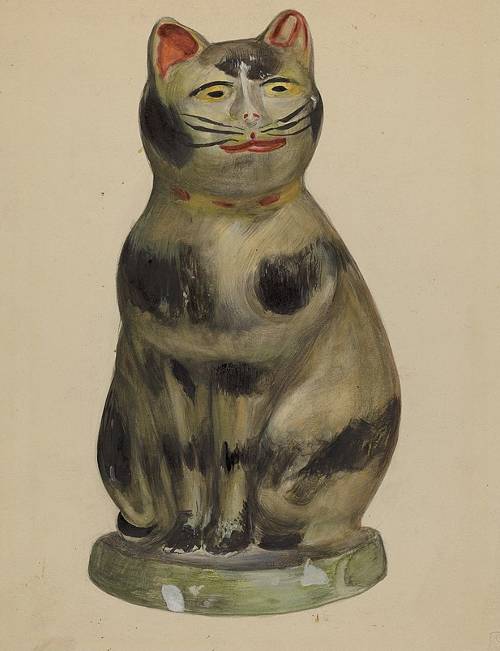
What is chalkware?

This photo of a chalkware cat, provided by Wiki Media, was probably given out as a carnival prize.
Chalkware, Plaster of Paris, and Gypsum
Chalkware is made from Plaster of Paris (and occasionally sculpted from blocks of gypsum). It is used to create figurines.
Chalkware was especially popular in the 19th Century (before plastics became popular).
Plaster of Paris is a mix of powdered and heat-treated gypsum. When the powdered gypsum is mixed with water, the gooey substance can be molded, shaped, or spread on surfaces like wooden lathing – where it is left to dry. Depending on size and thickness, the Plaster of Paris hardens into a solid over time, usually within a few days. It is often used in construction, sculpture, and for making decorative objects.
Did you ever use one of those kits where you made a hand or foot print to keep as a memento? That white stuff used as the base was Plaster of Paris and the result was a piece of chalkware!
Chalkware carnival prizes
In this short video, I share my experience with chalkware, while showing examples of chalkware figurines, chalkware bobble heads, chalkware religious icons, and chalkware wall hangings.
Chalkware is collectible.
Chalkware was once given away as carnival prizes. Lamps, figurines, and other decorative items could be had for a song.
Since it is easily chipped and cracked, vintage chalkware in perfect condition is hard to find. Most chalkware is painted with tempura, watercolors, or oil paints. Old chalkware often has missing paint and chips.
Repaired and repainted chalkware is usually acceptable to a collector, if it is done well. Of course, some chalkware collectors only buy pieces with original paint. Pristine pieces are rare and expensive!
Modern day chalkware
There are still a few artists that work in chalkware. Of of the most famous studios is Vaillancourt Folk Art, located in Maine. These craftsmen and craftswomen are putting out beautiful examples of collectible chalkware ranging in price from $30 to $2,000 and up.
Dust your chalkware often so dirt doesn't collect on it.
Do not put chalkware in water! If you must, wash it with an almost dry, barely damp cloth - but test a spot first to see if you like the results.
Can chalkware harm children or pets?
Chalkware is pretty safe unless painted with lead paint. Lead paint is poisonous and can be fatal to babies, small children, and pets if they eat enough of it.
It's probably best to keep children and pets away from your chalkware just in case they decide to lick it or take a bite.
More about gypsum
Chalkware is made from gypsum. Gypsum is a soft sulfate mineral composed of calcium sulfate dihydrate. It is mined from the ground and is used in fertilizer, blackboard chalk, drywall, plaster, and chalkware.
Gypsum is not poisonous but care should be used when working with it. Do not ingest gypsum or inhale the dust.
Gypsum can cause severe constipation when eaten. Breathing the dust can cause irritation. Gypsum dust irritates the eyes, the nose, and damages the respiratory system. You do not want your lungs full of any kind of dust so take care when mixing plaster or using gypsum.
The following video teaches us the history of chalkware, shows a variety of collections, and gives a casting demonstration of chalkware figurines:
Thanks so much for reading my blog. Jan.
© 2023 website design and content by Janice Boling